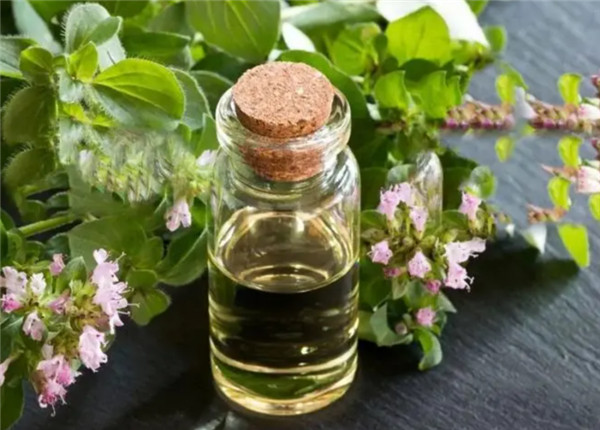There are several methods for extracting oregano oil as following:
Steam distillation extraction: This is one of the most common methods. Fresh oregano plant material (mainly leaves and flowers) is suspended over boiling water, and the steam pulls the essential oils out of the plant. The rising steam is captured in a container and flows down a tube, where it quickly cools and recondenses into water. The essential oils are then separated from the water and collected.
Solvent reflux extraction: This method uses an organic solvent, such as ethanol, to extract oregano oil. The oregano plant material is soaked in a solvent, which is heated to reflux the solvent, thereby extracting the essential oils from the plant. The solvent is then separated from the essential oils by distillation or other methods.
Microwave-assisted extraction: Microwave heating technology is used to accelerate the release of essential oils from the plant material, which is then collected by distillation or other methods.
Simultaneous distillation extraction: This is a method that combines distillation and solvent extraction. During the distillation process, an organic solvent is added to the plant material to more effectively extract the essential oils.
Supercritical fluid extraction: Using supercritical fluid (such as carbon dioxide) as an extractant, by adjusting the pressure and temperature, the supercritical fluid has a solubility similar to that of a liquid and a diffusion capacity similar to that of a gas, so as to effectively extract essential oils from oregano plants.
In addition, there is also a comprehensive extraction method, which includes pretreatment steps such as screening, cutting, washing and drying fresh oregano, and then ultrafiltration membrane filtration, nanofiltration membrane filtration and reverse osmosis concentration, and finally obtains a concentrate (i.e. oregano oil) and a permeate (i.e. oregano essence).
Introduction to essential oils
Extraction part: leaves
Extraction method: steam distillation
Odor description: herbal, spicy, green leaves, camphor fragrance
Main chemical components: carvacrol, thymol
Oregano essential oil, derived from the wild plant oregano, which grows mostly in Greece, Portugal and other Mediterranean regions, has been regarded as a herb with strong medicinal value since ancient times. From ancient Greek herbal classics to modern scientific research, oregano essential oil has always been widely concerned for its excellent anti-inflammatory, antibacterial and antiviral properties. This article will explore in detail the various uses of oregano essential oil to help you make better use of this natural treasure.

Basic knowledge and characteristics
Oregano essential oil, also known as wild marjoram essential oil, is extracted from oregano leaves by steam distillation. Its main chemical components include carvacrol and thymol, which give oregano essential oil powerful antibacterial, antiviral and antioxidant capabilities. Oregano essential oil is considered to be one of the most powerful natural anti-inflammatory and antibacterial agents known to date, and can even fight certain super bacteria such as MRSA (methicillin-resistant Staphylococcus aureus).
Oregano essential oil: a natural super antibiotic
Oregano essential oil, a magical plant from the genus Origanum in the Lamiaceae family, is used to extract this precious essential oil from its entire plant. Through distillation, we get light yellow to orange-yellow oregano essential oil, which has a strong and rich grassy and spicy aroma, with a hint of camphor.
The main ingredients of oregano essential oil include carvacrol, thymol and γ-terpinene, which give it a variety of properties:
Powerful antibacterial properties: Oregano essential oil is considered to be a powerful natural antibacterial agent that can effectively inhibit and kill a variety of bacteria, fungi and viruses.
High concentration and irritation: Due to its high concentration of ingredients, direct use may cause strong irritation to the skin and mucous membranes, and usually needs to be diluted before use.
Warming properties: It helps promote blood circulation and brings a warm feeling.
Rich smell: Oregano essential oil has a strong and unique grassy and spicy smell.
Antioxidant properties: It can fight free radicals and protect cells from oxidative damage.
Immunomodulation: It can stimulate and regulate the immune system and enhance the body's resistance and defense capabilities.
Digestive aid: It can help relieve discomfort in the digestive system, such as promoting the secretion of digestive juices, reducing flatulence and indigestion.
Volatile: Its ingredients are easy to evaporate and need to be properly stored.
The antibacterial effect of oregano essential oil hydrosol is better than that of single eugenol and carvacrol, because long-term use of single-ingredient drugs will cause bacteria to develop resistance to them and pass on resistance genes to other bacteria. At the same time, plant herbs have a variety of compounds that destroy the drug resistance mechanism of bacteria and enhance the activity of natural plant antibacterial drugs. This complex antibacterial mechanism of plant essential oil hydrosol makes it difficult for bacteria to develop resistance to it. In addition, the non-major active ingredients of oregano essential oil hydrosol may have an additive effect with the main active ingredients. Therefore, the antimicrobial effect of oregano essential oil hydrosol extracted from nature and containing all active ingredients is better than that of a single antibacterial ingredient synthesized or refined artificially.
Oleoresins Introduction
Stainless Steel Mixing Equipment Application
Plate Centrifuges Application
Contact: Project Manager
Phone: +86-18120438367
Tel: +86-18120438367
Email: info@tycoretech.com
Add: No. 1, Optics Valley Avenue, East Lake New Technology Development Zone, Wuhan, Hubei, China
We chat
